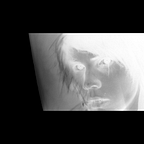Learning about simplicity from Tale of the Princess Kaguya
When I first saw screenshots from Studio Ghibli’s 2013 feature film, The Tale of The Princess Kaguya, directed by Isao Takahata, I was surprised. The film features a very simple, transparent style, in both colors and details. In my subjective, honest opinion it seemed boring, or uninteresting at first, even though I am a lover of their films.
I watched the film and fell in love with it.
And now after re-watching it, I re-fell in love with it.
It gets to my heart and soul every time: the characters, the emotions and the story. For those not familiar with the story and The Tale of The Bamboo-Cutter, it is a story about a poor bamboo cutter and his wife, adopting a little girl he found in the woods, seeing her grow unnaturally fast and eventually having to see her leave again as she has to go back to her celestial home, the moon. It is a story about the beautiful, yet crude cycles of earth, which constitutes life as a temporary existence, filled with precious and invaluable things. It is a story telling us how our lives here on earth will end one day, and that we should enjoy every single part of it.
Even the painful, stressful, confusing and heavy parts.
And my effort was to show how The Princess Kaguya fully enjoyed the richness of life on Earth that is filled with colour and all sorts of creatures as well as the joy of living and of forming emotional bonds.
The style of the film is made with simple brush strokes, muted colors which fades around the focal point. The animation on the other hand, is far from simple. Without much details in the backgrounds and desaturated colors, our attention is directed towards movement and emotion; two things which are very attractive to us humans. Movement triggers our curiosity, as movement is result of thinking and a decision being made. If a character moves towards something, we’re innately wondering what she’s up to.
The result of such a simple style lets us focus on pure acting and emotions. Which is why the theme of the film perfectly goes hand in hand with the style. The style underlines the theme. Purity. Traditional. Simple.
I noticed the effect of this style, when I watched it the second time. My memories of the film was far more vivid than what I was seeing again, yet there was no sense of disappointment. You never see detailed overview shots, or intricate background elements. Everything fades to white beyond what the director wants you to focus on. You see exactly what you need to see, in order for the story to evolve in your mind. The story evolves almost like a reading book in your mind, a book with sounds, music and movement, but still allowing things to grow beautifully. Giving you space.
That’s what I love about the concept of simplicity. Its effect to allow space. Not filling our minds with details, just so that we won’t have to think for ourselves. Films (including animation) have the opportunity to show us directly the details of a story through visuals and audio. That doesn’t mean one needs to put as much information in there as possible, to fill every pixel with information to make the story easier to understand. What Takahata does in this film is underline the theme, the purpose of the film with the style itself, as well as preserving the beautiful art form of traditional painting.
My point is that simple can be used to its advantage. One does not need million dollars invested in a project to create the most stunning visual images to tell a story. I, myself often feel hindered by lack of resources in order to create stories. I tend to long for a specific visual style, a visual quality that the whole story would depend on, and that way of thinking simply interferes with creativity and writing.
It is already proven that even the simplest of styles can go as far as winning Oscars.
We need to let the idea of ‘the more complicate, the better’ go and allow simplicity to pull a blanket over our stories. Finding the core in the story, and even stripping it of elements (designing by subtraction) which does not support the armature of the story. We need to let our creativity flow, build on our individuality, and then revising it with a critical mind, because we do not need more, bigger, faster. We need honest feelings, emotions which makes us human. So live and let your heart flow.
And enjoy every part of it.
Even the painful, stressful, confusing and heavy parts.
